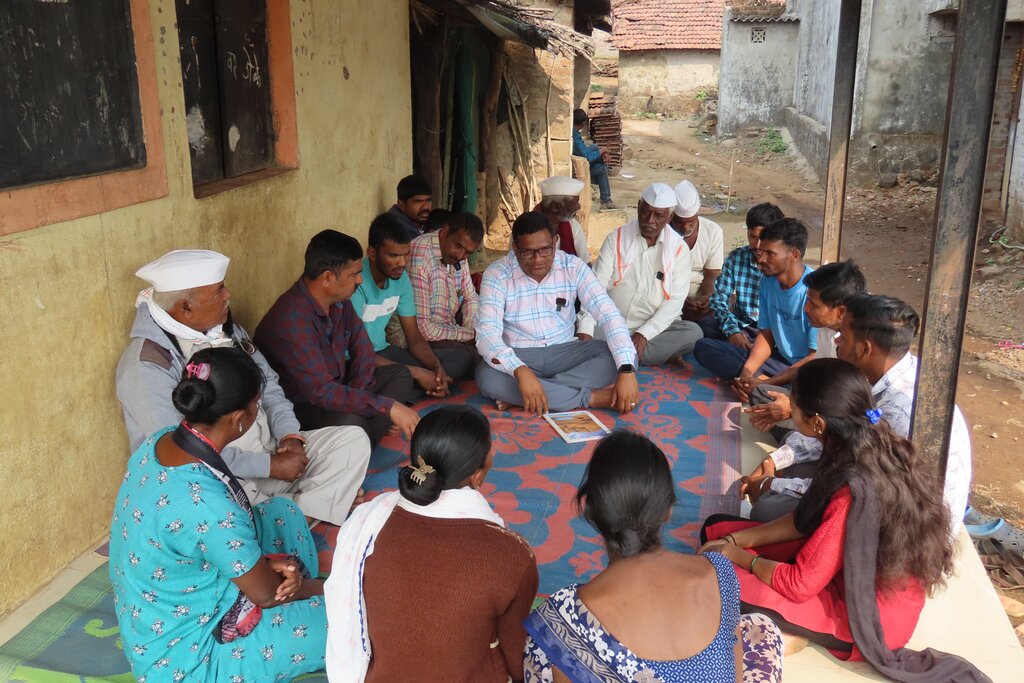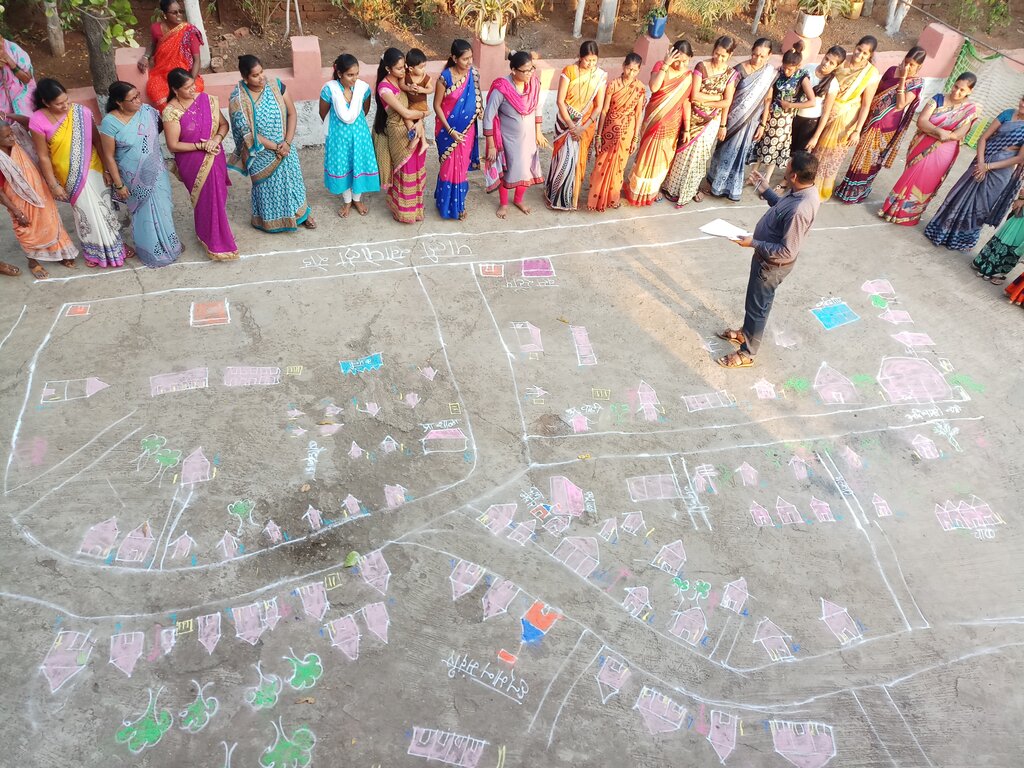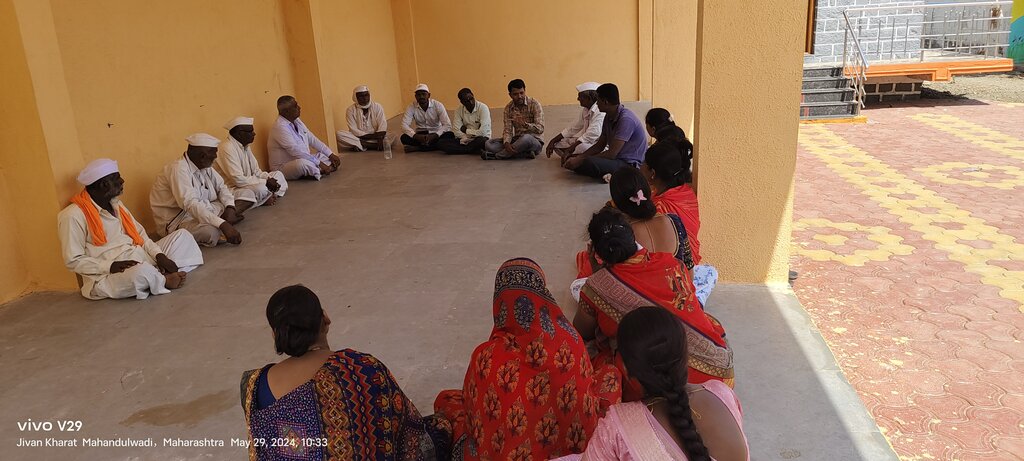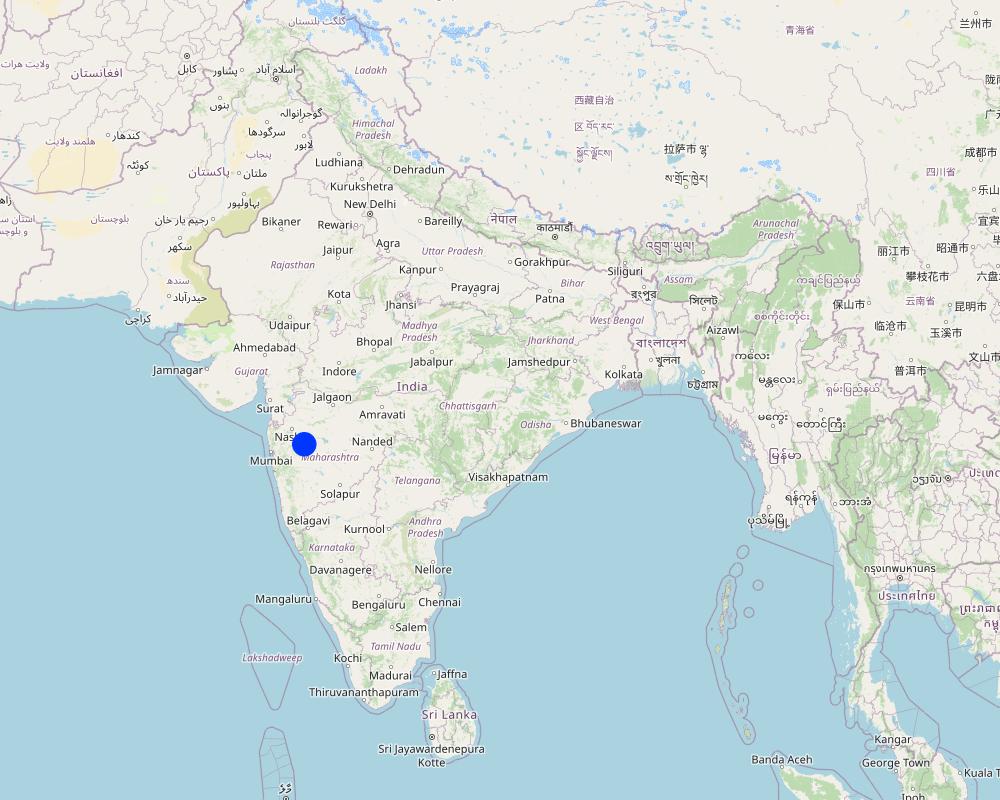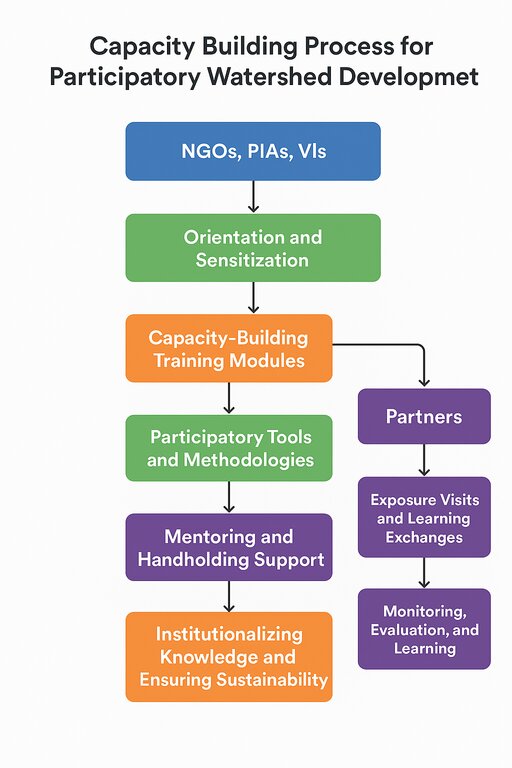Capacity Building Process for Participatory Watershed Development [อินเดีย]
- ผู้สร้างสรรค์:
- การอัพเดท:
- ผู้รวบรวม: Arun Bhagat
- ผู้เรียบเรียง: –
- ผู้ตรวจสอบ: Udo Höggel
Community Participation in Participatory Watershed Development
approaches_7656 - อินเดีย
ดูส่วนย่อย
ขยายทั้งหมด ย่อทั้งหมด1. ข้อมูลทั่วไป
1.2 รายละเอียดที่ติดต่อได้ของผู้รวบรวมและองค์กรที่เกี่ยวข้องในการประเมินและการจัดเตรียมทำเอกสารของแนวทาง
วิทยากรหลัก
ผู้เชี่ยวชาญ SLM:
Rajapure Ganesh
+91 9422226412
ganesh.rajapure@wotr.org.in
Watershed Organisation Trust (WOTR)
Paryavaran Sarasnagar Road, Behind, Market Yard Road, Ahilyanagar, Maharashtra 414001
อินเดีย
ผู้เชี่ยวชาญ SLM:
D’Souza Marcella
+91 9422226415
marcella.dsouza@gmail.com
W-CReS (the WOTR Centre for Resilience Studies), Watershed Organisation Trust (WOTR), Pune
The Forum, 2nd Floor, Pune - Satara Rd, above Ranka Jewellers, Padmavati Nagar, Corner, Maharashtra 411009
อินเดีย
ผู้เชี่ยวชาญ SLM:
ผู้เชี่ยวชาญ SLM:
Dadas Dada
+91 9892763960
dada.dadas@wotr.org.in
W-CReS (the WOTR Centre for Resilience Studies), Watershed Organisation Trust (WOTR), Pune
The Forum, 2nd Floor, Pune - Satara Rd, above Ranka Jewellers, Padmavati Nagar, Corner, Maharashtra 411009
อินเดีย
ผู้เชี่ยวชาญ SLM:
Khedkar Vishnu
+91 7798818283
vishnu.khedkar@wotr.org.in
W-CReS (the WOTR Centre for Resilience Studies), Watershed Organisation Trust (WOTR), Pune
The Forum, 2nd Floor, Pune - Satara Rd, above Ranka Jewellers, Padmavati Nagar, Corner, Maharashtra 411009
อินเดีย
ชื่อของโครงการซึ่งอำนวยความสะดวกในการทำเอกสารหรือการประเมินแนวทาง (ถ้าเกี่ยวข้อง)
Watershed Organisation Trust (WOTR) - อินเดีย1.3 เงื่อนไขที่เกี่ยวข้องกับการใช้ข้อมูลที่ได้บันทึกไว้ผ่านทาง WOCAT
วันที่เก็บรวบรวมข้อมูล (ภาคสนาม):
24/09/2025
ผู้รวบรวมและวิทยากรหลักยอมรับเงื่อนไขเกี่ยวกับการใช้ข้อมูลที่ถูกบันทึกผ่านทาง WOCAT:
ใช่
2. คำอธิบายของแนวทาง SLM
2.1 การอธิบายแบบสั้น ๆ ของแนวทาง
The Capacity Building Process for Participatory Watershed Development is a structured approach to strengthen the technical, managerial, and social skills of Non-Governmental Organizations (NGOs), Partner Implementation Agencies (PIAs), and Village-level Institutions (VIs). It includes orientation, training, participatory tools, mentoring, exposure visits, monitoring, and institutionalization. The process enhances competencies, fosters creativity and confidence, promotes community ownership, and ensures effective, sustainable planning, implementation, and management of watershed-based natural resource management and climate-resilient interventions.
2.2 การอธิบายอย่างละเอียดของแนวทาง
การอธิบายอย่างละเอียดของแนวทาง:
Capacity Building Process for Participatory Watershed Development:
Many Non-Governmental Organizations (NGOs), Partner Implementation Agencies (PIAs), and Village-level Institutions (VIs) aspire to implement participatory natural resource management (NRM) using a watershed approach. However, they often lack the technical expertise, practical skills, and experience needed for effective implementation. To address this gap, a structured capacity-building and induction strategy is essential. Such a strategy strengthen the technical and managerial competencies, nurtures creativity, and enhances their confidence to plan, implement, and sustain watershed interventions. In turn, it transforms their approach to resource mobilization, management, and sustainability. A common environmental challenge—such as water scarcity, land degradation, and climate change—creates opportunities to unite communities around shared needs. The Watershed Organisation Trust (WOTR) has effectively used watershed development as a unifying framework to bring people together, encouraging collective action for improving livelihoods and building resilience—especially among the poor and vulnerable.
Purpose of Capacity Building:
The overarching goal of the capacity-building process is to develop the knowledge, skills, attitudes, and confidence of NGOs, PIAs, and VIs in designing, implementing, and sustaining participatory, watershed-based NRM and climate-resilient development interventions.
Expected Outcomes:
•Improved competence in managing watershed-based NRM and climate change adaptation.
•Strengthened community ownership and participation.
•Effective and sustainable implementation of interventions.
•Positive transformation in approaches to resource mobilization and local governance.
Methodology and Key Steps:
The capacity-building approach comprises a series of interlinked steps, each reinforcing the others. Together, they form a comprehensive and adaptive learning process.
Step 1: Orientation and Sensitization
Objective: Build a common understanding and motivation among all project stakeholders.
Approach:
•Conduct orientation sessions explaining linkages between natural resources, livelihoods, and resilience.
•Share success stories and best practices to inspire commitment.
•Define roles and responsibilities of community-based organizations and NGOs.
Step 2: Capacity-Building Training Modules
Objective: Strengthen technical and managerial skills, especially among field-level stakeholders.
Core Modules:
•Technical Skills: Soil and water conservation, water budgeting, sustainable agriculture, climate resilience, and ecosystem-based adaptation.
•Social & Institutional Development: Social mobilization, gender inclusion, facilitation, group dynamics, and strengthening local institutions.
•Project Management: Planning, budgeting, reporting, and monitoring for effective implementation.
Step 3: Participatory Tools and Methodologies
Objective: Equip local groups with practical tools for participatory planning and action.
Tools and Methods:
•Participatory Rural Appraisal (PRA) tools such as resource mapping, seasonal calendars, and wealth ranking.
•Participatory Net Planning (PNP) for micro-level watershed planning.
•Use of digital tools and simple MIS platforms for data management and progress tracking.
Step 4: Mentoring and Handholding Support
Objective: Ensure continued learning, quality implementation, and motivation.
Approach:
•On-site technical and managerial guidance by experienced facilitators or resource NGOs.
•Regular review and feedback meetings to troubleshoot challenges.
•Peer learning and cross-visits among different project sites for shared learning.
Step 5: Exposure Visits and Learning Exchanges
Objective: Promote experiential and peer-to-peer learning.
Approach:
•Organize visits to successful watershed and NRM sites.
•Facilitate interactions with experienced community institutions and farmer groups.
•Encourage farmer-to-farmer extension to build local confidence and innovation.
Step 6: Monitoring, Evaluation, and Learning (MEL)
Objective: Foster accountability, reflection, and adaptive learning.
Approach:
•Train partners in participatory monitoring, data collection, documentation, and reporting.
•Develop and use simple, participatory monitoring tools to track outcomes and learning.
•WOTR’s existing participatory MEL tools are adapted for partners to ensure consistent data and insights.
Step 7: Institutionalizing Knowledge and Ensuring Sustainability
Objective: Build long-term local ownership and reduce dependence on external support.
Approach:
•Develop local resource persons, for example para-professionals.
•Establish local training and resource centers for continuous on-the-ground support.
•Document best practices, lessons learned, and local innovations for knowledge sharing.
•Gradually transfer leadership and responsibility to community institutions.
2.3 รูปภาพของแนวทาง
ข้อสังเกตทั่วไปเกี่ยวกับรูปภาพ:
Photos of activities like resource mapping are important as they visually document community participation, local knowledge, and the planning process. They help capture the involvement of villagers, the use of PRA tools, and the mapping outcomes. Such photos serve as powerful evidence of participatory planning, support monitoring and reporting, and effectively communicate project processes and impacts to stakeholders and partners.
2.5 ประเทศ ภูมิภาค หรือสถานที่ตั้งที่ได้นำแนวทางไปใช้
ประเทศ:
อินเดีย
ภูมิภาค/รัฐ/จังหวัด: :
Maharashtra, MadhyaPradesh, Telangana, Karnataka, Jharkhand, Odisha, Chhattisgarh states
ข้อมูลเฉพาะเพิ่มเติมของสถานที่ตั้ง:
Ahilyanagar, Jalna, Hyderabad, Sanga Reddy, Mandala, Gajapati, Rayagada, and more, etc.
ความคิดเห็น:
Watershed Organisation Trust (WOTR), established in 1993, has been actively engaged in capacity building since its inception (Stared from this location). This participatory approach continues to be implemented in WOTR-supported villages across nine states in India.
Map
×2.6 วันที่เริ่มต้นและสิ้นสุดของแนวทาง
ถ้าไม่รู้ปีที่แน่นอนให้ประมาณวันที่ที่ริเริ่มใช้แนวทางนี้ :
10-50 ปี
ความคิดเห็น:
Year of termination is not applicable because capacity building is essential in participatory watershed management.
2.7 ประเภทของแนวทาง
- The capacity-building process (approach) combines traditional and indigenous knowledge, recent local innovations, and project or program-based approaches for effective and sustainable watershed management.
2.8 เป้าหมายหรือวัตถุประสงค์หลักของแนวทาง
The main aims/objectives of the Capacity Building Process for Participatory Watershed Development are
• Strengthen technical, social, and managerial skills of NGOs, PIAs, and Village-level Institutions for effective watershed management.
• Promote participatory planning, community ownership, and active engagement in watershed interventions.
• Build project management capacity, including planning, budgeting, monitoring, and reporting.
• Support continuous learning through mentoring, exposure visits, and peer exchanges.
• Ensure sustainability by institutionalizing knowledge, developing local resource persons, and transferring leadership to communities.
2.9 เงื่อนไขที่เอื้ออำนวยหรือเป็นอุปสรรคต่อการนำเทคโนโลยีภายใต้แนวทางนี้ไปปฏิบัติใช้
บรรทัดฐานและค่านิยมทางสังคม วัฒนธรรม ศาสนา
- เอื้ออำนวย
Living together for a common purpose forms the foundation of society. A strong sense of ownership and active participation is essential for achieving sustainable development.
การมีไว้ให้หรือการเข้าถึงแหล่งการเงินและบริการ
- เอื้ออำนวย
Transparency acts as a social audit, it serves as an effective tool for accountability and openness.
การจัดตั้งระดับองค์กร
- เอื้ออำนวย
It provides a platform for community members to develop and exercise leadership.
การร่วมมือหรือการทำงานประสานกันของผู้ลงมือปฏิบัติ
- เอื้ออำนวย
It forms the foundation for building strong and sustainable institutions.
- เป็นอุปสรรค
Conflicts may arise among community members due to differing opinions, taboos, or perceptions.
กรอบแนวทางในการดำเนินการด้านกฎหมาย (การถือครองที่ดิน สิทธิในการใช้ที่ดินและน้ำ)
- เอื้ออำนวย
Village-level Institutions (VIs) are linked with the local governing body, i.e., the Village Panchayat.
นโยบาย
- เอื้ออำนวย
It facilitates the process of social auditing.
การกำกับดูแลที่ดิน (การตัดสินใจ การนำเอาไปปฏิบัติใช้ และการบังคับใช้)
- เอื้ออำนวย
It enhances community participation in planning and implementation.
ความรู้เกี่ยวกับ SLM การเข้าถึงการสนับสนุนด้านเทคนิค
- เอื้ออำนวย
Through training that provides technical knowledge on the project’s key components.
ตลาด (จัดซื้อปัจจัยนำเข้า ขายผลิตภัณฑ์) และราคา
- เอื้ออำนวย
Training materials can be procured.
ปริมาณงานที่ทำได้ กำลังคนที่มีให้
- เอื้ออำนวย
Provides local animators to assist in project implementation.
3. การมีส่วนร่วมและบทบาทของผู้มีส่วนได้ส่วนเสียที่เกี่ยวข้อง
3.1 ผู้มีส่วนได้ส่วนเสียที่เกี่ยวข้องในแนวทางนี้และบทบาท
- ผู้ใช้ที่ดินระดับท้องถิ่นหรือชุมชนระดับท้องถิ่น
Farmers, Women, and Youth
Consent to work, willingness to participate in mobilization activities, and attendance at capacity-building events.
- องค์กรที่ขึ้นอยู่กับชุมชน
Men, Women, and Local Representatives
Making informed decisions and managing conflicts effectively. Encouraging active community participation, carefully selecting beneficiaries, and monitoring the impacts of interventions.
- ผู้เชี่ยวชาญ SLM หรือที่ปรึกษาการเกษตร
NGO staff and team members
Planning, implementing, and monitoring activities
- นักวิจัย
Researchers and community members (men and women) involved in planning, implementation, and impact monitoring
Researchers design and guide training activities, facilitate knowledge sharing, provide technical expertise, monitor progress, and assess the impact of interventions to strengthen the skills and capacities of communities and stakeholders.
- ครู เด็กนักเรียน หรือนักศึกษา
School and nursery teachers.
Facilitating learning, guiding children, and supporting community education initiatives
- องค์กรพัฒนาเอกชน
Board members
Board resolution
- ภาคเอกชน
Technical Expert - Individual or Group
Support to the SLM specialist
- รัฐบาลระดับท้องถิ่น
Gram Panchayat (PRI)
Local governance body
Necessary resolutions
- รัฐบาลแห่งชาติ (ผู้วางแผน ผู้ทำการตัดสินใจ)
Concern Departments
Content and Guidelines for Capacity-Building Efforts
- องค์การระหว่างประเทศ
Donor Agencies
Content and Guidelines for Capacity-Building Efforts
Funding, technical support, and guidance for community development and capacity-building initiatives
ถ้ามีผู้มีส่วนได้ส่วนเสียหลายคนที่เกี่ยวข้องให้ระบุหน่วยงานตัวแทน:
The main implementing agency will take the lead role in planning, coordinating, and executing the activities (Capacity-building processes are closely linked to project implementation, so the project’s nodal agency takes the lead role).
3.2 การเกี่ยวข้องของผู้ใช้ที่ดินระดับท้องถิ่นหรือชุมชนระดับท้องถิ่นในช่วงต่างๆของแนวทาง
| ความเกี่ยวข้องของผู้ใช้ที่ดินระดับท้องถิ่นหรือชุมชนระดับท้องถิ่น | ระบุผู้ที่มีส่วนเกี่ยวข้องและอธิบายกิจกรรม | |
|---|---|---|
| การริเริ่มหรือการจูงใจ | ระดมกำลังด้วยตนเอง | Community members need to demonstrate their willingness to actively participate in project planning and implementation. |
| การวางแผน | ปฏิสัมพันธ์ | Farmers, CBO (Community-Based Organisation) members, women, and village-level animators actively participate in planning and review meetings, and contribute by passing resolutions in CBO meetings. |
| การดำเนินการ | ปฏิสัมพันธ์ | Farmers, CBO members, women, and the project team actively participate in executing activities and in collecting relevant contributions. |
| การติดตามตรวจสอบหรือการประเมินผล | ปฏิสัมพันธ์ | CBO members participate in joint monitoring visits and share information for impact documentation and research studies. |
| ปฏิสัมพันธ์ |
3.3 แผนผังแสดงขั้นตอนการทำงาน (ถ้ามี)
คำอธิบาย:
This visual is illustrating a Capacity Building Process for Participatory Watershed Development using a step-by-step flowchart.
It starts with key implementing institutions such as NGOs, PIAs, and Village Institutions (VIs). The process begins with Orientation and Sensitization, followed by Capacity-Building Training Modules that strengthen skills and technical knowledge. From here, the approach branches into two parallel components:
1. Participatory Tools and Methodologies → enabling communities to actively take part in planning and decision-making.
2. Partners → supporting collaboration through exposure visits and knowledge sharing.
The next stage provides Mentoring and Handholding Support to guide field-level implementation.
Finally, the process moves to Institutionalizing Knowledge and Ensuring Sustainability, ensuring that skills, systems, and learnings remain within the community for long-term development impact. Overall, the diagram shows a structured learning pathway that builds capacity, supports practical application, and ensures sustainable watershed management.
ผู้เขียน:
Dr. Arun Bhagat
3.4 การตัดสินใจเลือกใช้เทคโนโลยี SLM
ระบุผู้ที่ทำการตัดสินใจเลือกเทคโนโลยีมากกว่าหนึ่งวิธีไปปฏิบัติใช้:
- ผู้ลงมือปฏิบัติที่เกี่ยวข้องทั้งหมดในฐานะที่เป็นส่วนรวมของแนวทาง
การอธิบาย:
The NGO plays a leading role in initiating the process, while community members become actively involved as the process progresses.
ระบุว่าการตัดสินใจตั้งอยู่บนพื้นฐานของ:
- การประเมินความรู้ SLM ที่ได้ทำการบันทึกไว้เป็นอย่างดี (การใช้ข้อมูลในการตัดสินใจ)
4. การสนับสนุนด้านเทคนิค การสร้างขีดความสามารถ และการจัดการด้านความรู้
4.1 การสร้างขีดความสามารถ / การอบรม
ได้มีการจัดอบรมให้แก่ผู้ใช้ที่ดินหรือผู้มีส่วนได้ส่วนเสียคนอื่น ๆ หรือไม่:
ใช่
ให้ระบุว่าใครเป็นผู้ได้รับการอบรม:
- ผู้ใช้ที่ดิน
- เจ้าหน้าที่ภาคสนาม / ที่ปรึกษา
ถ้าเกี่ยวข้อง ให้ระบุ เพศ อายุ สถานภาพ ชาติพันธุ์ เป็นต้น:
Community members of all age groups.
รูปแบบการอบรม:
- กำลังดำเนินการ
- เกษตรกรกับเกษตรกร
- ใช้พื้นที่ทำการสาธิต
- จัดการประชุมสู่สาธารณชน
หัวข้อที่พูด:
Key concepts and topics include: Environmental degradation, Natural Resource Management, Watershed Development, Participatory planning and monitoring tools, Community participation and contributions, Role of stakeholders, Portfolio management, Women empowerment, Gender inclusion, Sustainable agriculture, and Post-project management.
ความคิดเห็น:
Training modules are designed to meet the specific needs of the project and location.
4.2 การบริการให้คำแนะนำ
ผู้ใช้ที่ดินมีการเข้าถึงการรับบริการให้คำปรึกษาหรือไม่:
ใช่
ระบุว่ามีบริการให้คำปรึกษาหรือไม่:
- ไปเยี่ยมชมสถานที่
การอธิบาย/แสดงความคิดเห็น:
In today’s era of climate change and volatile markets, Indian farmers face growing challenges that affect productivity and food security. Unlike urban areas that benefit from the digital revolution, rural farmers need timely, localized, and actionable information on sustainable farming practices. WOTR’s FarmPrecise app addresses this need, providing a comprehensive, data-driven tool to support informed agricultural decisions. Previously, WOTR developed an Agromet Advisory System delivering crop- and location-specific advisories via SMS using data from the India Meteorological Department (IMD). While valuable for weather forecasts, this system lacked personalization and direct farmer engagement.
WOTR launched the FarmPrecise app in 2019 to provide dynamic, farm-specific advisories. Since then, it has grown substantially, with over 1 lakh downloads, covering 30 crops across the Indian States of Maharashtra, Telangana, Odisha, and Madhya Pradesh, and is available in five languages: English, Hindi, Marathi, Telugu, and Odia.
4.3 การเสริมความแข็งแกร่งให้กับสถาบัน (การพัฒนาองค์กร)
สถาบันได้รับการจัดตั้งขึ้นมาหรือเสริมความแข็งแกร่งโดยแนวทางนี้หรือไม่:
- ใช่ อย่างมาก
ระบุระดับของสถาบันที่ได้รับการเสริมความแข็งแกร่งหรือจัดตั้งขึ้นมา:
- ท้องถิ่น
อธิบายถึงสถาบัน บทบาทและความรับผิดชอบ สมาชิก เป็นต้น:
Village Development Committee (VDC): Responsible for planning and executing project activities, selecting beneficiaries and work sites, managing conflicts, overseeing community contributions, ensuring quality supervision and monitoring, maintaining records, and conducting social audits.
Self-Help Groups (SHGs): Organize women into savings and credit groups and manage SHG operations.
Village Water Management Team: Promote water budgeting, coordinate water governance, and support sustainable water management practices.
ระบุประเภทของการให้ความช่วยเหลือสนับสนุน:
- การสร้างขีดความสามารถ / การอบรม
ให้รายละเอียดเพิ่มเติม :
Capacity-building inputs are delivered in a sequence of trainings aligned with the project cycle tenure.
4.4 การติดตามตรวจสอบและประเมินผล
การติดตามตรวจสอบและประเมินผลเป็นส่วนหนึ่งของแนวทางหรือไม่:
ใช่
ความคิดเห็น:
In regular Community-Based Organization (CBO) trainings, the monitoring component is a key focus area.
ถ้าตอบว่าใช่ แสดงว่าการจัดเตรียมเอกสารนี้มุ่งหวังที่จะเอาไปใช้สำหรับการติดตามตรวจสอบและประเมินผลใช่หรือไม่:
ใช่
ความคิดเห็น:
It is used for follow-up purposes as well as for knowledge dissemination.
4.5 การวิจัย
การวิจัยเป็นส่วนหนึ่งของแนวทางหรือไม่:
ใช่
ระบุหัวข้อเรื่อง:
- สังคมวิทยา
- เศรษฐศาสตร์หรือการตลาด
- นิเวศวิทยา
- เทคโนโลยี
ให้ข้อมูลเพิ่มเติมและให้ระบุผู้ทำการวิจัย:
The baseline survey tool is used for impact documentation. It helps reach beneficiaries to record their quality of life and assess the effects of project activities.
5. การสนับสนุนด้านการเงินและวัสดุอุปกรณ์
5.1 ระบุงบประมาณประจำปีสำหรับแนวทาง SLM นี้
ถ้าหากว่างบประมาณประจำปีไม่เป็นที่ทราบแน่นอน ให้ระบุช่วงลงไป:
- < 2,000
แสดงความคิดเห็น (แหล่งของการระดมทุน ผู้บริจาคคนสำคัญ):
Main sources of funding / major donors: National and international donors, and Corporate Social Responsibility (CSR) contributions.
5.2 การสนับสนุนด้านการเงิน / วัสดุอุปกรณ์ให้แก่ผู้ใช้ที่ดิน
ผู้ใช้ที่ดินได้รับการสนับสนุนด้านการเงิน / วัสดุอุปกรณ์ไปปฏิบัติใช้เทคโนโลยีหรือไม่:
ใช่
ถ้าใช่ ให้ระบุประเภทของการสนับสนุน เงื่อนไขและผู้จัดหามาให้:
Although not through direct financial or material support, land users (community) benefit from improved skills and knowledge, and gain advantages through active participation and involvement.
5.3 เงินสนับสนุนสำหรับปัจจัยนำเข้า (รวมถึงแรงงาน)
- ไม่มี
ถ้าแรงงานโดยผู้ใช้ที่ดินเป็นปัจจัยนำเข้าที่มีอยู่มากมาย ระบุด้วยว่าเนื่องจาก:
- สมัครใจ
ความคิดเห็น:
While labor is not required, participation of land users in the capacity-building process is essential. Landowners contribute their knowledge and time to share ideas and insights.
5.4 เครดิต
มีการจัดหาเครดิตมาให้ภายใต้แนวทาง SLM หรือไม่:
ไม่ใช่
5.5 แรงจูงใจหรือเครื่องมืออื่น ๆ
แรงจูงใจหรือเครื่องมืออื่น ๆ ได้ถูกนำไปใช้ส่งเสริมการใช้เทคโนโลยี SLM หรือไม่:
ไม่ใช่
6. การวิเคราะห์ผลกระทบและการสรุป
6.1 ผลกระทบของแนวทาง
ทำให้ผู้ใช้ที่ดินระดับท้องถิ่นมีอำนาจขึ้น ปรับปรุงการเข้าร่วมของผู้มีส่วนได้ส่วนเสียให้ดีขึ้นหรือไม่:
- ไม่ใช่
- ใช่ เล็กน้อย
- ใช่ ปานกลาง
- ใช่ อย่างมาก
Greater awareness and better understanding of project management and its impact on project components led to higher participation
ช่วยในการตัดสินใจโดยดูจากหลักฐาน ได้หรือไม่:
- ไม่ใช่
- ใช่ เล็กน้อย
- ใช่ ปานกลาง
- ใช่ อย่างมาก
The progress of project components is presented in common meetings, such as Gram Sabhas, enabling CBO members to make informed decisions.
ช่วยให้ผู้ใช้ที่ดินนำเอาเทคโนโลยี SLMไปใช้และบำรุงรักษาสภาพไว้ได้หรือไม่:
- ไม่ใช่
- ใช่ เล็กน้อย
- ใช่ ปานกลาง
- ใช่ อย่างมาก
Active and well-informed participation in planning, execution, and ensuring quality work.
ปรับปรุงความร่วมมือกันและการดำเนิน งานของ SLM ได้อย่างมีประสิทธิผลหรือไม่:
- ไม่ใช่
- ใช่ เล็กน้อย
- ใช่ ปานกลาง
- ใช่ อย่างมาก
Capacity building produces synergistic outcomes.
ระดมกำลังหรือปรับปรุงการเข้าถึงแหล่ง เงินทุนสำหรับการดำเนินการ SLM หรือไม่:
- ไม่ใช่
- ใช่ เล็กน้อย
- ใช่ ปานกลาง
- ใช่ อย่างมาก
The participatory Net Planning (PNP) tool in support of capacity building approach facilitates proper land-use planning with budget allocation for specific plots.
ปรับปรุงความรู้และความสามารถของผู้ใช้ที่ดินในการดำเนินการ SLM หรือไม่:
- ไม่ใช่
- ใช่ เล็กน้อย
- ใช่ ปานกลาง
- ใช่ อย่างมาก
Capacity building activities and net planning exercises provide inputs on the technical know-how of watershed structures.
ปรับปรุงความรู้และความสามารถของผู้มีส่วนได้ส่วนเสียคนอื่น ๆ ให้ดีขึ้นหรือไม่:
- ไม่ใช่
- ใช่ เล็กน้อย
- ใช่ ปานกลาง
- ใช่ อย่างมาก
The capacity-building approach improved stakeholders’ knowledge and skills through training, hands-on exercises, participatory planning, and active involvement in decision-making.
ทำให้ผู้ใช้ที่ดินระดับท้องถิ่นมีอำนาจขึ้น ปรับปรุงการเข้าร่วมของผู้มีส่วนได้ส่วนเสียให้ดีขึ้นหรือไม่:
- ไม่ใช่
- ใช่ เล็กน้อย
- ใช่ ปานกลาง
- ใช่ อย่างมาก
The capacity-building process brings all stakeholders onto a common platform, fostering a shared vision, sustainable impact, and resilience.
ช่วยบรรเทาความขัดแย้งหรือไม่:
- ไม่ใช่
- ใช่ เล็กน้อย
- ใช่ ปานกลาง
- ใช่ อย่างมาก
It helps unite the community and reduces conflicts related to resource management.
ทำให้กลุ่มด้อยโอกาสมีอำนาจทางสังคมและเศรษฐกิจหรือไม่:
- ไม่ใช่
- ใช่ เล็กน้อย
- ใช่ ปานกลาง
- ใช่ อย่างมาก
The principle of equity was upheld during the capacity-building process, with community members from all sectors actively involved and given equal representation in CBO and VI structures.
ปรับปรุงความทัดเทียมกันด้านเพศและให้อำนาจแก่ผู้หญิงและเด็กผู้หญิงหรือไม่:
- ไม่ใช่
- ใช่ เล็กน้อย
- ใช่ ปานกลาง
- ใช่ อย่างมาก
Special emphasis was placed on women, with a separate Plan of Participation (POP) developed to ensure their inclusion and promote gender equity.
ส่งเสริมให้เยาวชนหรือบุตรหลานของผู้ใช้ที่ดินให้เข้าร่วมใน SLM:
- ไม่ใช่
- ใช่ เล็กน้อย
- ใช่ ปานกลาง
- ใช่ อย่างมาก
Special focus was placed on engaging youth in the net planning process to ensure their active participation in local support and supervision.
ปรับปรุงประเด็นของการถือครองที่ดินหรือสิทธิในการใช้ ซึ่งขัดขวางการนำเทคโนโลยีไปใช้ให้ดีขึ้น:
- ไม่ใช่
- ใช่ เล็กน้อย
- ใช่ ปานกลาง
- ใช่ อย่างมาก
Informal land user issues are resolved during the implementation process.
นำไปสู่ความมั่นคงด้านอาหารหรือปรับปรุงโภชนาการให้ดีขึ้น:
- ไม่ใช่
- ใช่ เล็กน้อย
- ใช่ ปานกลาง
- ใช่ อย่างมาก
A well-designed capacity-building process ensures quality implementation, leading to better outcomes.
ปรับปรุงการเข้าถึงตลาดหรือไม่:
- ไม่ใช่
- ใช่ เล็กน้อย
- ใช่ ปานกลาง
- ใช่ อย่างมาก
Market-related inputs are included in the training modules.
นำไปสู่การเข้าถึงเรื่องน้ำและสุขาภิบาลได้ดีขึ้นหรือไม่:
- ไม่ใช่
- ใช่ เล็กน้อย
- ใช่ ปานกลาง
- ใช่ อย่างมาก
A well-designed capacity-building process leads to quality implementation, resulting in positive outcomes.
นำไปสู่การใช้ที่ดินอย่างยั่งยืนหรือแหล่งพลังงานหรือไม่:
- ไม่ใช่
- ใช่ เล็กน้อย
- ใช่ ปานกลาง
- ใช่ อย่างมาก
The capacity-building approach promoted sustainable energy use by training stakeholders on efficient practices, demonstrating renewable technologies, and encouraging participatory planning for optimal resource use.
ปรับปรุงความสามารถของผู้ใช้ที่ดินในการปรับตัวให้เข้ากับการเปลี่ยนแปลงของสภาพภูมิอากาศหรือสภาพที่รุนแรงและภัยพิบัติหรือไม่:
- ไม่ใช่
- ใช่ เล็กน้อย
- ใช่ ปานกลาง
- ใช่ อย่างมาก
A well-designed capacity-building process, combined with effective training, ensures quality implementation, leading to positive outcomes and impacts, while enhancing individuals’ resilience through adaptation.
นำไปสู่โอกาสในการจ้างงาน รายได้หรือไม่:
- ไม่ใช่
- ใช่ เล็กน้อย
- ใช่ ปานกลาง
- ใช่ อย่างมาก
Improved agriculture creates both on-farm and off-farm livelihood opportunities.
6.2 แรงจูงใจหลักของผู้ใช้ที่ดินเพื่อที่จะนำ SLM ไปปฏิบัติใช้
- การผลิตที่เพิ่มขึ้น
Enhanced soil moisture and soil quality, along with increased awareness and adoption of improved agricultural practices.
- การเสื่อมของที่ดินลดลง
Reduced soil erosion and land degradation, along with improved knowledge of water and land management practices.
- กฎและระเบียบ (ค่าปรับ) หรือการบังคับใช้
Land users practice and uphold equality at all levels.
- จิตสำนึกด้านสิ่งแวดล้อม
Integration of climate change–related topics into capacity-building strategies.
- ความรู้และทักษะ SLM ที่เพิ่มพูนขึ้น
A structured and systematic process for implementing Sustainable Land Management (SLM) practices.
6.3 ความยั่งยืนของกิจกรรมของแนวทาง
ผู้ใช้ที่ดินสามารถทำให้สิ่งต่างๆ ที่ได้ปฏิบัติใช้โดยแนวทางนี้ยั่งยืนได้หรือไม่ (โดยไม่มีการสนับสนุนจากภายนอก):
- ใช่
ถ้าตอบว่าใช่ ให้อธิบายว่าอย่างไร :
The principle of ‘learning by doing’ is central to the capacity-building process. Communities gain hands-on experience in various project components, developing strong technical and managerial skills at the local level. This enhances sustainability, as trained village institutions such as VDC members and community workers possess the necessary knowledge and skills for continued implementation and impact documentation.
6.4 จุดแข็งและข้อได้เปรียบของแนวทาง
| จุดแข็ง / ข้อได้เปรียบของแนวทางในทัศนคติของผู้ใช้ที่ดิน |
|---|
| Inclusion of Indigenous Knowledge: The approach allows local and traditional knowledge to be integrated into planning and implementation, making interventions more relevant and practical to the local context. |
| Enhanced Knowledge on NRM: Land users gain valuable knowledge and information about Natural Resource Management (NRM), helping them make informed decisions on soil, water, and land use practices. |
| Leadership Development: Community members get opportunities to take leadership roles in planning and decision-making processes, strengthening local governance and ownership. |
| Social Inclusion: The process ensures participation from all sections of society, including marginalized groups, women, and youth, promoting equity and collective action. |
| จุดแข็ง / ข้อได้เปรียบของแนวทางในทัศนคติของผู้รวบรวมหรือวิทยากรหลัก |
|---|
| Systematic Approach: The capacity-building process follows a structured and step-by-step framework, ensuring consistency, clarity, and efficiency in planning, implementation, and monitoring. |
| Tested and Proven Strategy: The approach is based on field-tested methodologies and past experiences, which have demonstrated successful outcomes in participatory watershed and NRM projects. |
| Operational Guidelines: Well-defined operational guidelines provide a clear roadmap for facilitators and implementing agencies, helping to standardize procedures and maintain quality across different project sites. |
| Set of Tools: The process includes a comprehensive toolkit—such as participatory planning tools, training modules, and monitoring formats—which helps streamline learning, participation, and evaluation. |
6.5 จุดอ่อน / ข้อเสียเปรียบของแนวทางและวิธีในการแก้ไข
| จุดอ่อน / ข้อเสียเปรียบในทัศนคติของผู้ใช้ที่ดิน | สามารถแก้ไขปัญหาได้อย่างไร |
|---|---|
| Time Constraints: The capacity-building process requires continuous engagement, which can be time-consuming and may interfere with regular livelihood activities of land users. |
Flexible Organization of Capacity-Building (CB) Events: Conduct training and awareness sessions at times and locations convenient for community members to ensure higher participation, especially for women and farmers with field responsibilities. Use of Social Media and Digital Platforms: Share project updates, training materials, and success stories through WhatsApp groups, community radio, and other social media tools to reach a wider audience effectively. |
| Lack of Confidence to Participate: Some community members, especially those with limited education or exposure, may initially hesitate to engage actively in discussions or decision-making. |
Rapport Building: Establishing trust and positive relationships with community members helps facilitators engage participants more effectively and encourages open communication. Interactive Methods – Games, Exercises, Personal Talks, and Corner Meetings: Use participatory and informal methods to make learning enjoyable, build confidence, and promote active involvement among community members. Use of Participatory Rural Appraisal (PRA) Tools: PRA methods like mapping, ranking, and seasonal calendars help participants express local knowledge and experiences, increasing confidence and ownership in the planning process. |
| Social Constraints and Gender Barriers: Cultural taboos and social norms may restrict women’s participation in meetings or leadership roles, limiting their ability to contribute fully to capacity-building and project implementation. |
Encouraging attendance and use of Information: Motivate community members to regularly attend meetings, apply shared knowledge in their practices, and contribute ideas for better project outcomes. Confidence Building Among Men and Women: Conduct targeted sessions to enhance the confidence of both men and women, ensuring balanced participation and reducing gender-based hesitation in community discussions. |
| จุดอ่อน / ข้อเสียเปรียบในทัศนคติของผู้รวบรวมหรือวิทยากรหลัก | สามารถแก้ไขปัญหาได้อย่างไร |
|---|---|
| Language and Cultural Barriers: Differences in language and cultural practices can make it difficult to communicate technical concepts effectively, especially in diverse and multi-lingual communities. | Rapport Building and Understanding of the Community: Spend adequate time in the field to understand local culture, traditions, and social dynamics. Building mutual trust enhances participation and improves the quality of capacity-building interventions. |
| Limited Literature in Local Language: The scarcity of training materials and technical documents in local languages restricts understanding and limits wider participation at the grassroots level. | Translation of Reading and Training Materials: Translate manuals, handouts, and key reference materials into local languages to make technical content accessible to all community members and ensure uniform understanding. |
| Communication and Facilitation Skills: Successful capacity building depends on skilled facilitators. In some cases, inadequate communication or facilitation skills among trainers can reduce the effectiveness of training sessions and field interactions. | Upgrading Skills of Trainers and Facilitators: Provide regular refresher training and exposure opportunities for facilitators to enhance their communication, facilitation, and technical skills—ensuring more effective delivery of capacity-building programs. |
7. การอ้างอิงและการเชื่อมต่อ
7.1 วิธีการหรือแหล่งข้อมูล
- ไปเยี่ยมชมภาคสนาม การสำรวจพื้นที่ภาคสนาม
Two field visits are conducted to engage the village community in discussions on the capacity-building process, its impact, importance, and role in fostering ownership.
- การสัมภาษณ์กับผู้ใช้ที่ดิน
Interviews were conducted with six land users.
- การสัมภาษณ์ผู้เชี่ยวชาญด้าน SLM หรือผู้ชำนาญ
Interviews were conducted with five land users.
- การเก็บรวบรวมมาจากรายงานและเอกสารที่มีอยู่
The information is sourced from a capacity-building methodology that has been developed and is currently under publication.
7.2 การอ้างอิงถึงสิ่งตีพิมพ์
ชื่อเรื่อง ผู้เขียน ปี ISBN:
WATERSHED DEVELOPMENT GUIDELINES (Revised 2001), Community and Rural Development Department,
ช่องทางในการสืบค้น และราคา:
https://megcnrd.gov.in/forms/WSD.pdf
ชื่อเรื่อง ผู้เขียน ปี ISBN:
The Wasundhara Approach. 2013. Watershed Organisation Trust (WOTR).
ช่องทางในการสืบค้น และราคา:
https://www.yumpu.com/en/document/read/19427351/the-wasundhara-approach-wotr
7.3 เชื่อมโยงกับข้อมูลที่มีอยู่บนออนไลน์
ชื่อเรื่องหรือคำอธิบาย:
Wasundhara Approach, Watershed Organisation Trust (WOTR)
URL:
https://www.youtube.com/watch?v=r3YHpkm9qFY&t=364s
ชื่อเรื่องหรือคำอธิบาย:
Water Gives Life, Watershed Organisation Trust (WOTR)
URL:
https://www.youtube.com/watch?v=thdevpZ-vio&t=149s
ชื่อเรื่องหรือคำอธิบาย:
How to do Wealth Ranking in Watershed
URL:
https://www.youtube.com/watch?v=ygiAy7f7Gpc
ชื่อเรื่องหรือคำอธิบาย:
Wasundhara
URL:
https://www.youtube.com/watch?v=r3YHpkm9qFY&t=364s
ชื่อเรื่องหรือคำอธิบาย:
A New Beginning
URL:
https://www.youtube.com/watch?v=LBzF7DXbedM&t=2s
ชื่อเรื่องหรือคำอธิบาย:
Rising Together: Building Resilient Communities for a Sustainable Tomorrow
URL:
https://www.youtube.com/watch?v=0gCFkwkfwdg&t=2s
ลิงก์และโมดูล
ขยายทั้งหมด ย่อทั้งหมดลิงก์
ไม่มีลิงก์
โมดูล
ไม่มีโมดูล



